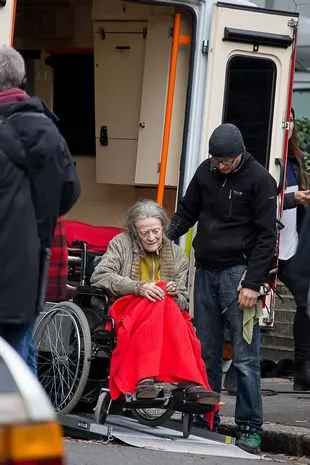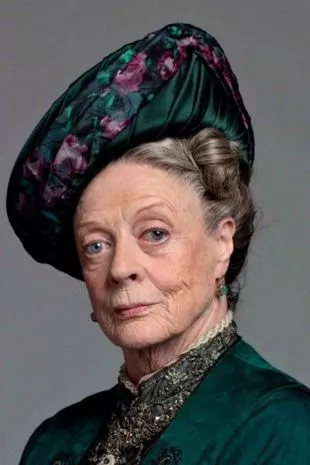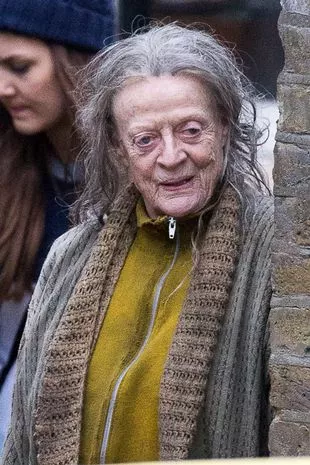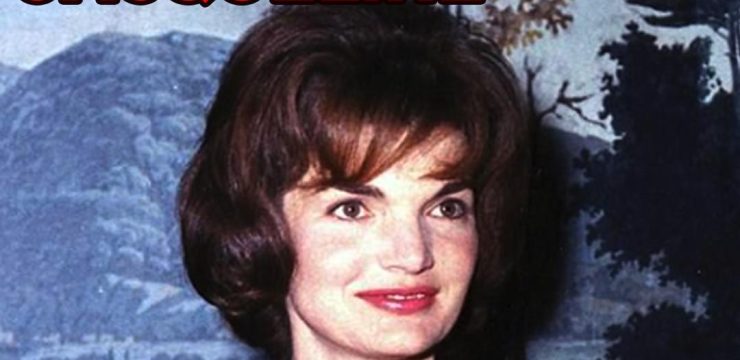What would the Dowager Countess of Grantham say if she could see her now? Dame Maggie Smith, the legendary actress revered for her role as the aristocratic Violet Crawley in Downton Abbey, has taken a striking departure from her gentrified persona in her latest project, The Lady in the Van. This new venture showcases the immense versatility of the 79-year-old veteran, as she transforms into the homeless and eccentric Miss Mary Shepherd in the upcoming BBC drama based on Alan Bennett’s autobiographical play.
Gone are the impeccable manners and the iconic, sharp-witted one-liners that defined her Downton Abbey character. Instead, audiences will see Dame Maggie embody a far grittier and more vulnerable role, marked by a visual transformation that is both poignant and arresting. With disheveled gray hair cascading untamed around her face, the celebrated actress is seen wrapped in a blanket, portraying the struggles of a woman living on the margins of society. In one striking scene, her character is taken away in an ambulance, an image that starkly contrasts the dignified Dowager Countess audiences have come to admire.

The storyline of The Lady in the Van is deeply rooted in the real-life experiences of celebrated playwright Alan Bennett. The film’s narrative revolves around the peculiar yet heartwarming relationship between Bennett and Miss Shepherd, a homeless woman who spent over 15 years living in a series of dilapidated vans parked in the driveway of his Camden home. The character of Miss Shepherd is central to the plot, highlighting themes of resilience, human connection, and the delicate interplay of independence and dependence.
Alan Bennett’s diaries, which provide the foundation for the story, capture his nuanced reflections on this unusual relationship. Bennett’s writing reveals a blend of compassion, frustration, and humor as he recounts his interactions with Miss Shepherd. These entries were later adapted into a stage play, which has now been brought to life on screen under the direction of Nicholas Hytner, marking his second collaboration with Bennett since their work on the critically acclaimed The History Boys in 2006.
Maggie Smith’s portrayal of Miss Shepherd promises to be both moving and authentic, offering a glimpse into the life of a woman whose eccentricities mask a deeply human story. Her transformation for the role, both physically and emotionally, underscores her status as one of the greatest actresses of her generation. The vulnerability she brings to the character is a testament to her ability to delve into complex roles that challenge societal perceptions and evoke empathy from audiences.
Adding to the film’s rich tapestry of storytelling is Alex Jennings, who plays the role of Alan Bennett. Known for his ability to bring depth and authenticity to his characters, Jennings perfectly complements Smith’s performance. Together, they navigate the complexities of the relationship between a reserved playwright and a spirited, if not exasperating, homeless woman. Their on-screen dynamic captures the delicate balance of compassion and boundaries, a central theme that resonates throughout the film.
The production has also drawn attention for its behind-the-scenes collaborations. Nicholas Hytner’s direction, combined with Bennett’s sharp and poignant writing, creates a seamless blend of humor and pathos. The film’s cinematography captures the contrasting worlds of Camden’s bustling streets and the confined, makeshift quarters of Miss Shepherd’s van, effectively immersing viewers in the story’s unique setting.
The filming of The Lady in the Van comes shortly after the conclusion of the final season of Downton Abbey, a series that has left an indelible mark on the world of television. In the finale, audiences were treated to a moment of romantic tension as Prince Kuragin declared his love for Violet Crawley, reigniting memories of their shared past. Fans, however, will have to wait until the Christmas special to discover whether the Dowager Countess will act on his heartfelt proposition.
This juxtaposition of Maggie Smith’s roles—from the grandeur of Downton Abbey to the raw humanity of The Lady in the Van—is a testament to her remarkable range as an actress. While her portrayal of Violet Crawley has solidified her status as a cultural icon, her role as Miss Shepherd reminds audiences of her ability to tackle characters that challenge societal norms and shed light on marginalized voices.
Beyond the performances of its leads, The Lady in the Van also boasts an impressive supporting cast. Last month, James Corden, the breakout star of The History Boys and host of The Late Late Show, was spotted on set filming a cameo as a market stall vendor. Corden’s appearance adds a layer of familiarity and charm, tying back to the creative team’s previous successes.

The production’s ability to attract such talent speaks to the enduring appeal of Bennett’s storytelling. His ability to capture the quirks and idiosyncrasies of human behavior has resonated with audiences for decades, and this adaptation of The Lady in the Van is no exception. The film’s narrative strikes a delicate balance between humor and poignancy, offering moments of levity while addressing profound questions about dignity, community, and the human condition.
As the film progresses, audiences will witness the evolution of the relationship between Bennett and Miss Shepherd. What begins as a reluctant act of charity gradually transforms into a unique bond that defies conventional expectations. This journey is underscored by Bennett’s introspective commentary, which offers insight into his internal struggles and evolving perspective on Miss Shepherd’s presence in his life.
The real-life story of Mary Shepherd is as compelling as it is unconventional. Her past remains shrouded in mystery, with snippets of her history revealed through her interactions with Bennett and the residents of Camden. These glimpses into her life—marked by tragedy, resilience, and a steadfast refusal to conform—paint a portrait of a woman whose circumstances are shaped by both choice and circumstance.

Maggie Smith’s commitment to bringing this character to life is evident in every aspect of her performance. From her physical transformation to her nuanced portrayal of Miss Shepherd’s quirks and vulnerabilities, Smith ensures that the character is depicted with authenticity and respect. Her performance serves as a reminder of the importance of storytelling in fostering empathy and understanding for those who live on the fringes of society.
The release of The Lady in the Van is highly anticipated, not only for its stellar cast and creative team but also for its timely exploration of themes that remain relevant in today’s world. Homelessness, community, and the complexities of human connection are issues that continue to resonate, making the film’s message all the more poignant.
As Dame Maggie Smith continues to captivate audiences with her unparalleled talent, The Lady in the Van stands as a testament to her enduring legacy. The film’s ability to shed light on the overlooked stories of individuals like Mary Shepherd is a powerful reminder of the transformative power of cinema. Through her portrayal, Smith not only honors the memory of a remarkable woman but also challenges viewers to see beyond appearances and consider the stories that lie beneath.

In a year marked by significant milestones in her career, Maggie Smith’s willingness to embrace such a diverse range of roles is a testament to her passion for her craft. Whether as the witty Dowager Countess or the tenacious Miss Shepherd, she continues to push boundaries and redefine what it means to be an actress of her caliber. The Lady in the Van is more than just a film; it is a celebration of the human spirit and a tribute to the art of storytelling that Maggie Smith and Alan Bennett have mastered so beautifully.
As audiences prepare to bid farewell to Violet Crawley in Downton Abbey’s final Christmas special, they can look forward to welcoming a very different Maggie Smith in The Lady in the Van. This duality in her performances not only showcases her versatility but also reaffirms her place as one of the most beloved and respected figures in the entertainment industry. Through her work, Smith continues to inspire, challenge, and connect with audiences, leaving an indelible mark on the world of cinema and beyond.





